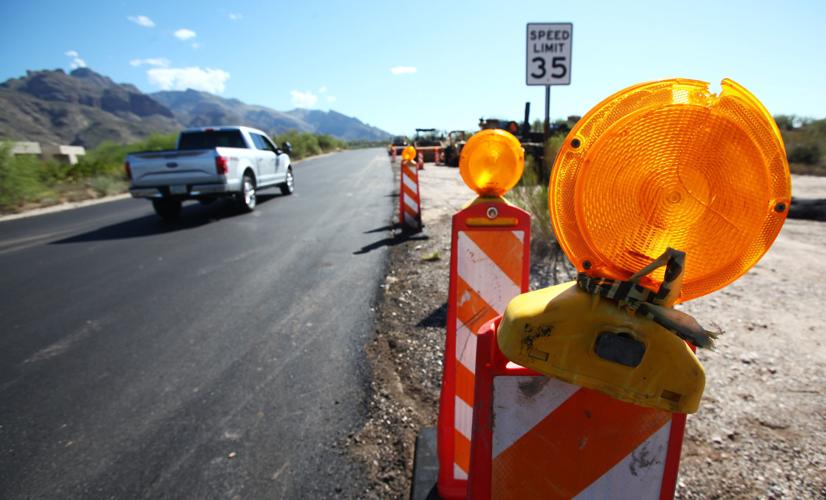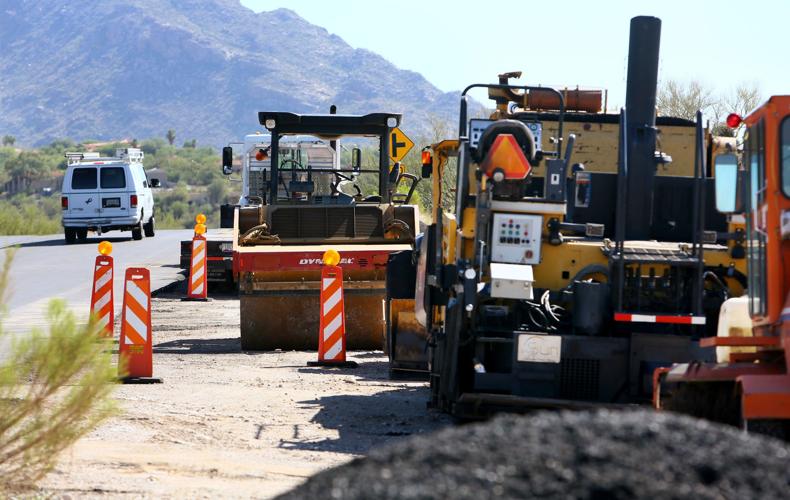If the proposed $430 million countywide road bond passes in November, it will represent the single largest investment in major street repairs in the history of Pima County.
But it won’t fix every road in the greater Tucson area. Not by a longshot.
A conservative estimate suggests it would take more than $1.8 billion to bring every road, street and stravenue up to excellent standards, and some officials are reluctant to discuss what they’d do with the funding if Proposition 463 passes.
The funds are also limited in how they can be used. It must be significant road work, which would include, at the minimum, resurfacing a road by putting on a new layer of asphalt to rebuilding the entire road from the ground up, and the worst roads must be addressed first.
Put another way, cities and towns will not be able to use the funds to fill potholes or put on a thin seal to prolong the life of a road in relatively good shape.
A critical aspect of Prop 463 is that the county’s secondary property tax rate wouldn’t change; instead, it will be extended at the current rate for the next 15 years.
DIVIDED SUPPORT
If voters were to reject it, those specific property taxes would begin to decrease as existing bond debt is paid off over the next decade.
The bond has been endorsed by a number of high-profile community groups, including the Tucson Metro Chamber, the Arizona Transportation Builders Association, the Southern Arizona Leadership Council and the executive committee of the Green Valley Council.
But it also has opposition, including a group known as Stop Prop 463 Road Bonds.
The group argues that Pima County has a poor track record of properly using the hundreds of millions of dollars it has received in Highway User Revenue Funds and Vehicle License Tax money, citing allegations made by Pima County Supervisor Ally Miller about financial mismanagement in the county’s Transportation Department.
Miller also submitted an argument as part of the official information packet opposing the bond.
“This bond will provide only $166,833,891 for unincorporated Pima County roads. That is less than two years of the HURF/VLT distributions Pima County is expected to receive from the state based upon the current year projection of $91 million,” Miller wrote. “Please stop enabling the mismanagement of your tax dollars by giving the county more of your money.”
The $166.8 million figure cited by Miller is slightly different than the official number from Pima County, with an Aug. 7, 2018, memo putting the amount at $166.2 million.
Also opposing the bond is Tucson City Councilman Steve Kozachik, who said the county is making the same mistake it did several years ago when it put $815 million in bonds on the ballot in 2015, including roughly $160 million set aside for road repairs.
Voters rejected the various measures.
“I don’t think this is a well-crafted option, and I think the county blew it,” Kozachik said. “It is shortsighted. It does not do long-term preservation.”
Kozachik pointed to the fact that there is no money set aside for relatively inexpensive pavement treatments designed to extend how long roads will stay in good condition.
Officials in both Oro Valley and Marana have been cool to the proposal publicly, in part because of an abundance of caution of a state law that strictly forbids public officials from advocating for ballot measures.
A secondary reason is a deep well of pride for the towns’ overall report card for street conditions, known as the overall conditions index.
The towns, which have newer streets when compared with their counterparts in the city of Tucson and Pima County, are bullish on the condition of their roads, saying they already have sufficient funding for streets maintenance.
COMPETING PRIORITIES
What the bond money would be used for is up to each city and town.
The formula, based on population estimates, would give Tucson nearly $200.7 million, Pima County would get less than $167 million for unincorporated areas, Marana would receive $26.1 million, Oro Valley would get $23.1 million and Sahuarita would receive about $12.2 million.
For the city of Tucson, there are plenty of areas where the bond money could be spent, said Robin Raine, interim director of the city’s Transportation Department.
“Our needs right now are about $850 million and about $200 million is major streets, so $200 million will make an impact,” she wrote.
If Prop 463 passes, the city would use a pre-existing community board that has made decisions on where to spend previously approved taxpayer-approved initiatives.
Pima County would rely on its road-conditions index to decide where to spend the money, said Pima County Transportation Department Director Ana Olivares.
Roughly a year ago, officials identified approximately $860 million in road projects throughout Pima County that needed attention for a different, now-scrapped road-improvement strategy.
“(The bond) will make a huge dent in what we have,” Olivares said.
Failing roads will be the priority, she said, but the county’s transportation advisory committee will be responsible for mapping out which roads will be fixed and when.
Oro Valley Town Manager Mary Jacobs said that if voters back the road bond, the millions of dollars that would go into the town’s coffers would be used to fix aging roads.
She argues that unlike other cities and towns in Pima County, Oro Valley doesn’t have millions of dollars in unfunded street repairs.
A few roads that would be eligible for funding are Northern Avenue, Shannon Road, Moore Road, and Pusch View Lane between the CDO wash bridge, Calle Concordia and Arizona 77 — better known as Oracle Road.
The latter is an important distinction, as it opens the door to potentially offering millions of dollars to the Arizona Department of Transportation to fix sections of Oracle Road inside of Oro Valley within the five-year program.
The proposal, Jacobs told the Star, was received warmly by local ADOT officials, who said it was possible that some traffic projects could be shuffled around if it meant the town would pay for a significant portion of the repairs to Arizona 77.
In the town of Marana, officials are tight-lipped on how they would spend the bond money if it’s approved by voters in November.
Mo El-Ali, the director of town’s Public Works Department, said the town identified roads it wanted to work on as part of the now-repealed countywide 25-cent property tax that was set aside for road repair.
He insisted that while the money will be put to good use, Marana’s roads are in good condition.
“Seventy-seven percent of our roads are really in good shape, and we have a good pavement preservation and management program,” he said.
The town’s transportation committee recently discussed Prop 463 but opted to wait until after November to identify specific projects.
“We will wait and see what the voters decide,” El-Ali said.
Early this summer, a survey conducted as part of a partnership between the Star and Strongpoint Opinion Research found that roughly 60 percent of respondents supported the then-unnamed Prop 463.






